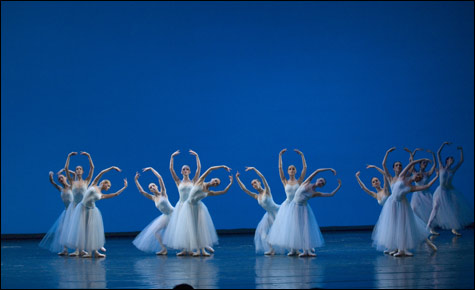
SERENADE: Glorious Kirov, glorious Balanchine — until the ladies didn’t let their hair down. |
NEW YORK — The end of a three-week, thousands-of-miles-from-home season is never the right time to assess a dance company, and that’s multiply true of the Kirov Ballet’s engagement at New York City Center, which ended this past Sunday. The usuals — injuries; tired, jaded dancers; audience-demoralizing last-minute substitutions — were just the beginning. Having found no room at the Metropolitan Opera House, where it had performed La Bayadère, Don Quixote, Swan Lake, and George Balanchine’s Jewels at the 2002 summer Lincoln Center Festival, the company had to settle for the theater that Balanchine and New York City Ballet abandoned in 1964 for the new and more capacious New York State Theater at Lincoln Center. (One apparent casualty of the smaller space was the “Kingdom of the Shades” entrance from the third act of La Bayadère, which was performed without the zigzag ramp.) Back home in St. Petersburg, meanwhile — well, that was the problem: the Kirov’s director, Makhar Vaziev, was back home, having failed to make the trip, amid rumors that he’s about to retire. Vaziev and Valery Gergiev, the general director of the Mariinsky Theatre (where the Kirov is based), do not see eye to eye these days; Gergiev — who, depending on who you talk to, does or doesn’t know jack about ballet — has criticized Vaziev in everything from choreography to casting and training. At home, the company is again known as the Mariinsky Ballet of St. Petersburg (both the theater and the troupe were named for Maria Aleksandrovna, wife of Tsar Aleksandr II), but it still tours under the familiar — to Westerners — name of the Leningrad Communist Party leader, Sergei Kirov, who was assassinated in 1934. Peter the Great had no brand-name guarantees when he built St. Petersburg in a swamp; perhaps this company should imitate him and go forward under the appellation it prefers.
The last time the Kirov appeared in Boston, in November 2006, it was to perform Swan Lake, at the Wang Theatre. There were no evening-length ballets at the City Center, only programs of Petipa (excerpts from Paquita, Raymonda, and La Bayadère) and Fokine (Chopiniana, Le spectre de la rose, The Dying Swan, Sheherazade) and William Forsythe (Steptext, Approximate Sonata, The Vertiginous Thrill of Exactitude, In the Middle, Somewhat Elevated), with the odd Vaganova (the Diana and Acteon pas de deux) and Harald Lander (Études) thrown in. Reviewing the opening Petipa program, Alastair Macaulay in the New York Times fired the first critical shot: “The Kirov is one of those ballet companies that too often present show-off steps as if the art lay nakedly in nothing but excellence of technical execution.” Freelancing for the Village Voice (the Paper That Used To Have a Dance Critic), Deborah Jowitt seemed to have had a better time: “The women sparkle like perfectly cut diamonds. You may occasionally fault their phrasing or their lack of emotional nuance, but never their technique.” Everybody noticed principal Uliana Lopatkina’s chin pointed defiantly at the upper balcony.

This past weekend, the Kirov’s New York season culminated in a Balanchine program: Serenade, Rubies, and Ballet Imperial. The company’s 2002 New York Jewels was an eye opener. Marcia Siegel in this paper observed that “in stepping into this choreography of Balanchine’s, the Kirov’s members seemed to be learning a different way to dance.” Laura Jacobs in the New Criterion wrote, “To see the company in this looming Balanchine after nine days of story ballets was to see them with nothing on but their dancing. And what a sight.” Even Macaulay in this past Tuesday’s Times described as a triumph the company’s “galvanized, glowing 2000–2002 accounts of Balanchine’s Rubies, and to a lesser extent, the rest of Jewels.”
What I saw in that 2002 Jewels was a company that stretched and softened what had become the New York City Ballet hard line without sacrificing sex or, for the most part, speed. This Balanchine might have lacked the élan of the Paris Opera Ballet’s, but it harbored greater innocence. That impression was confirmed by the first three movements of Serenade Saturday night. Titian-haired Ekaterina Kondaurova and Danila Korsuntsev made for a large, gracious Waltz Girl and Boy, she with her authoritative upper body and he with his easy tours jetés. The dancing had volume and extension and effortless lifts and pillowy phrasing; flipping turns were light-hearted rather than show-offy, and Ekaterina Osmolkina’s Russian Girl was a jubilant presence. There was even a puckeringly astringent traversal of Tchaikovsky’s cloying second-movement Waltz from Mikhail Agrest and the Orchestra of the Mariinsky Theatre; it elicited bittersweet waltzing from Kondaurova and Korsuntsev. And the religioso feel in the women’s-mysteries opening of the Tema Russo third movement led to gamboling that could have been inspired by the fairy footing in A Midsummer Night’s Dream.